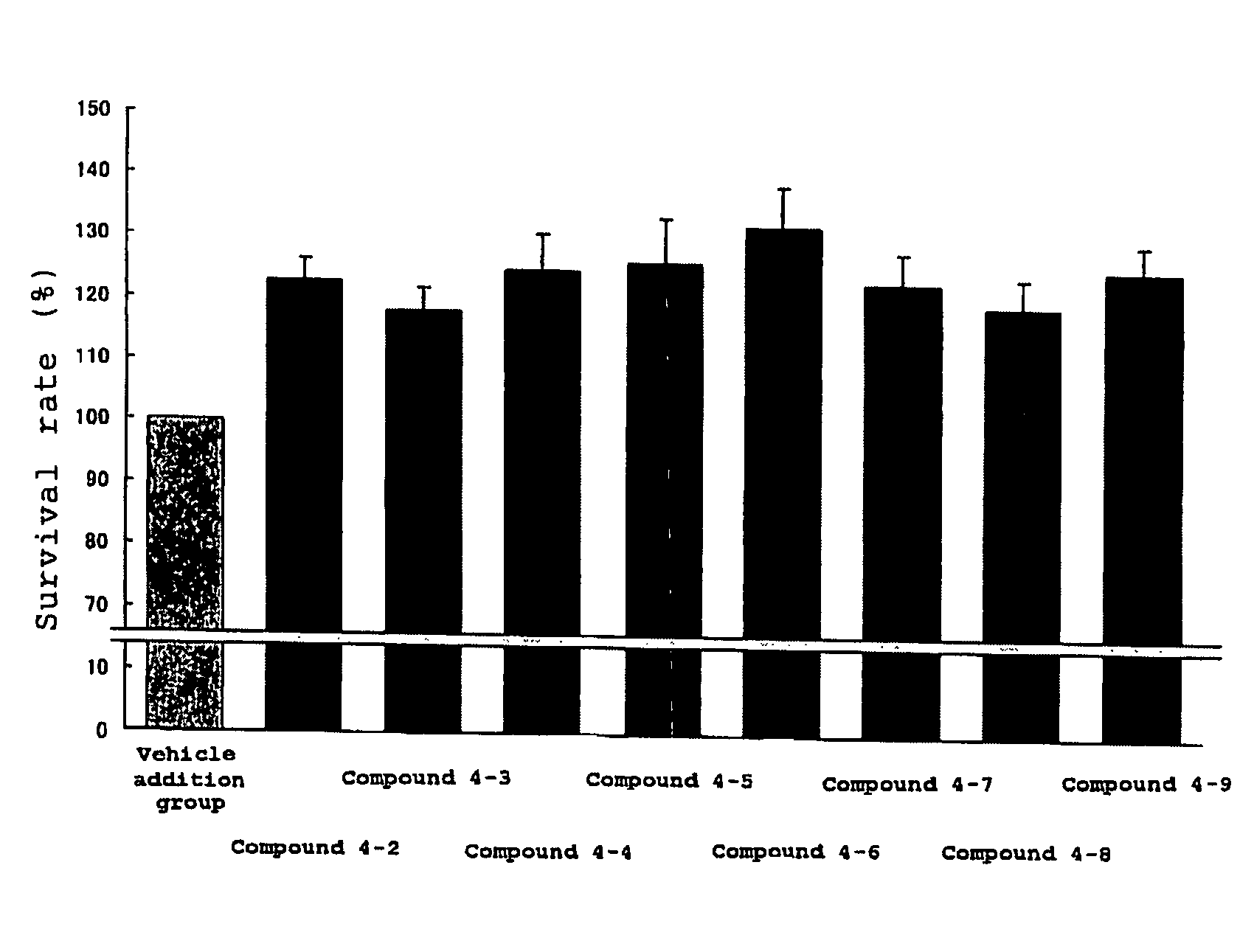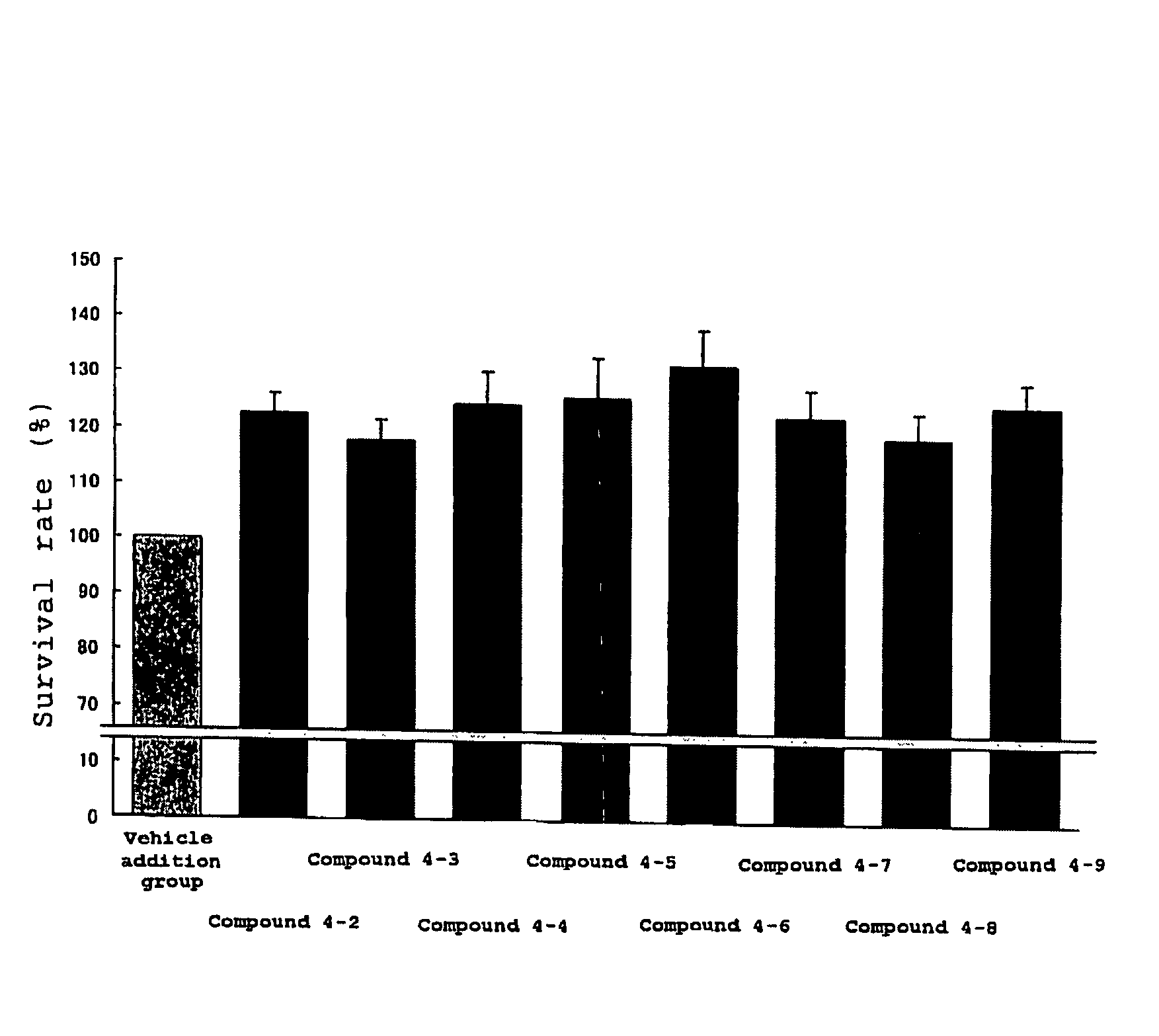Protective agent for retinal neuronal cell comprising indazole derivative as active ingredient
a technology of retinal neuronal cells and indazole derivatives, which is applied in the direction of biocide, drug compositions, peptide/protein ingredients, etc., can solve the problem of not disclosing the effect of protecting retinal neuronal cells of indazole derivatives at all, and achieve the effect of preventing or treating eye diseases
- Summary
- Abstract
- Description
- Claims
- Application Information
AI Technical Summary
Benefits of technology
Problems solved by technology
Method used
Image
Examples
production examples
Reference Example 1
Synthesis of 1-bromo-4-(1-cyano-1-methylethyl)benzene (Reference Compound 1-1)
[0071]
[0072]45 g (1100 mmol) of sodium hydride (a 60% dispersion in a mineral oil) was added in divided portions to a solution of 100 g (510 mmol) of 4-bromophenylacetonitrile in 1500 ml of N,N-dimethylformamide at 0° C. in an argon stream with stirring. Then, 95 ml (1500 mmol) of methyl iodide was added dropwise thereto at 0° C. with stirring and the mixture was stirred at 10° C. for 1 hour.
[0073]After the reaction was completed, the reaction solution was gradually poured into 900 g of a saturated aqueous solution of ammonium chloride, then 500 ml of water was added thereto and the mixture was extracted with 2000 ml of ethyl acetate. The organic layer was washed with a saturated aqueous solution of sodium chloride, dried over anhydrous sodium sulfate and concentrated under reduced pressure, whereby 110 g of the title compound was obtained as a dark brown oily substance (yield: 96%).
[007...
reference example 2
Synthesis of 4-(1-aminocarbonyl-1-methylethyl)-1-bromobenzene (Reference Compound 2)
[0082]
[0083]250 g (1800 mmol) of potassium trimethylsilanolate (purity: 90%) was added to a solution of 100 g (450 mmol) of 1-bromo-4-(1-cyano-1-methylethyl)benzene (Reference compound 1-1) in 1000 ml of toluene at room temperature in an argon stream with stirring and the mixture was stirred for 4.5 hours under a condition of heating to reflux.
[0084]After the reaction was completed, the reaction solution was cooled down to room temperature and 500 ml of water was added dropwise thereto. The mixed solution was stirred for 25 minutes at room temperature and the resulting solid was obtained by filtration and washed with 400 ml of water, whereby 99 g of the title compound was obtained as white powder (yield: 92%).
[0085]Melting point: 139 to 141° C.
[0086]Rf value: 0.23 (n-hexane:ethyl acetate=1:1 (v / v))
[0087]Mass spectrum (CI, m / z): 242, 244 (M++1)
[0088]1H-NMR spectrum (CDCl3, δppm): 1.56 (s, 6H), 5.18 (b...
reference example 3
Synthesis of 5-(1-aminocarbonyl-1-methylethyl)-2-bromopyridine (Reference Compound 3)
[0089]
[0090]9.60 ml (93.3 mmol) of a 35% aqueous solution of hydrogen peroxide and 1.86 g (13.5 mmol) of potassium carbonate were added to a solution of 1.50 g (6.66 mmol) of 2-bromo-5-(1-cyano-1-methylethyl)pyridine (Reference compound 1-2) in 15 ml of dimethyl sulfoxide at 0° C. and the mixture was stirred for 15 minutes. Then, a cooling bath was removed and the mixture was stirred on a water bath for 2 hours.
[0091]After the reaction was completed, the reaction solution was poured into 200 ml of water and the mixture was extracted with 500 ml of 1,2-dichloroethane. The organic layer was successively washed with water and a saturated aqueous solution of sodium chloride, dried over anhydrous magnesium sulfate and concentrated under reduced pressure, whereby 1.63 g of the title compound was obtained as white powder (yield: quantitative).
[0092]Rf value: 0.17 (n-hexane:ethyl acetate=1:1 (v / v))
[0093]Mas...
PUM
| Property | Measurement | Unit |
|---|---|---|
| thickness | aaaaa | aaaaa |
| weight | aaaaa | aaaaa |
| temperature | aaaaa | aaaaa |
Abstract
Description
Claims
Application Information
 Login to View More
Login to View More - R&D
- Intellectual Property
- Life Sciences
- Materials
- Tech Scout
- Unparalleled Data Quality
- Higher Quality Content
- 60% Fewer Hallucinations
Browse by: Latest US Patents, China's latest patents, Technical Efficacy Thesaurus, Application Domain, Technology Topic, Popular Technical Reports.
© 2025 PatSnap. All rights reserved.Legal|Privacy policy|Modern Slavery Act Transparency Statement|Sitemap|About US| Contact US: help@patsnap.com



